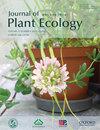Life form-dependent nitrogen-phosphorous allocation strategies of leaf and fine root in a temperate natural forest under long-term nitrogen addition
IF 3.9
2区 环境科学与生态学
Q2 ECOLOGY
引用次数: 0
Abstract
Nitrogen deposition has increased rapidly in eastern China, which can affect the stoichiometric characteristics of plants. However, the effects of N addition on the nitrogen (N) and phosphorous (P) allocation strategies for various plant life forms (e.g. trees, shrubs, and herbs) have rarely been studied. This study evaluated the effects of N addition on N and P stoichiometry and their scaling exponents in the leaves and fine roots of the different life form groups. N and P concentrations in the leaves of shrubs and herbs increased under N addition treatments, whereas tree leaves exhibited a more stable response. In contrast, N addition has no significant effect on N and P concentrations in the fine roots of the three plant life forms. N addition accelerated the allocation of more N and P to the leaves than to the fine roots in all three life forms. Furthermore, the N-P allocation scaling exponents of the leaves and fine roots of the trees were equal to 1.0, indicating an isometric pattern. In contrast, the N-P allocation scaling exponents of shrubs and herbs were less than 1.0, indicating an allometric pattern. Although high N availability promoted shrubs and herbs to distribute P to leaves at a higher proportion than N, only slight effects were detected in tree leaves. These changes in N-P allocation patterns indicate that life forms and N addition levels work together to modulate plants allocation strategies. This suggests the importance of life form categories when evaluating N-P allocation strategies in forest plants.长期加氮条件下温带天然林叶片和细根生命形态依赖的氮磷分配策略
中国东部地区氮沉降迅速增加,影响植物的化学计量特征。然而,氮添加对不同植物生命形式(如乔木、灌木和草本植物)氮、磷分配策略的影响研究很少。本研究评价了施氮量对不同生命形态类群叶片和细根氮磷化学计量及其标度指数的影响。施氮处理使灌木和草本植物叶片中氮、磷含量增加,而乔木叶片对氮、磷含量的响应更为稳定。相反,施氮量对三种植物细根氮磷浓度无显著影响。在所有三种生命形式中,氮素添加加速了更多的氮和磷分配给叶片而不是细根。叶片和细根的N-P分配尺度指数均为1.0,呈等距分布。灌木和草本植物的N-P分配尺度指数均小于1.0,表现为异速生长模式。高氮有效度虽然能促进灌木和草本植物以高于氮的比例向叶片分配磷,但对乔木叶片的影响不大。这些N- p分配模式的变化表明,生命形式和N添加水平共同调节植物的分配策略。这表明在评估森林植物氮磷分配策略时,生命形式类别的重要性。
本文章由计算机程序翻译,如有差异,请以英文原文为准。
求助全文
约1分钟内获得全文
求助全文
来源期刊

Journal of Plant Ecology
生物-植物科学
CiteScore
4.60
自引率
18.50%
发文量
134
审稿时长
3 months
期刊介绍:
Journal of Plant Ecology (JPE) serves as an important medium for ecologists to present research findings and discuss challenging issues in the broad field of plants and their interactions with biotic and abiotic environment. The JPE will cover all aspects of plant ecology, including plant ecophysiology, population ecology, community ecology, ecosystem ecology and landscape ecology as well as conservation ecology, evolutionary ecology, and theoretical ecology.
 求助内容:
求助内容: 应助结果提醒方式:
应助结果提醒方式:


